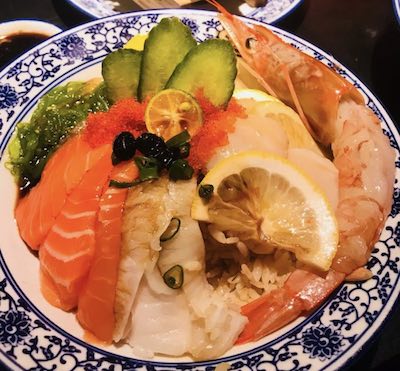We are reader supported. When you purchase through links on our site, we may earn an affiliate commission. Also, as an Amazon affiliate, we earn from qualifying purchases.
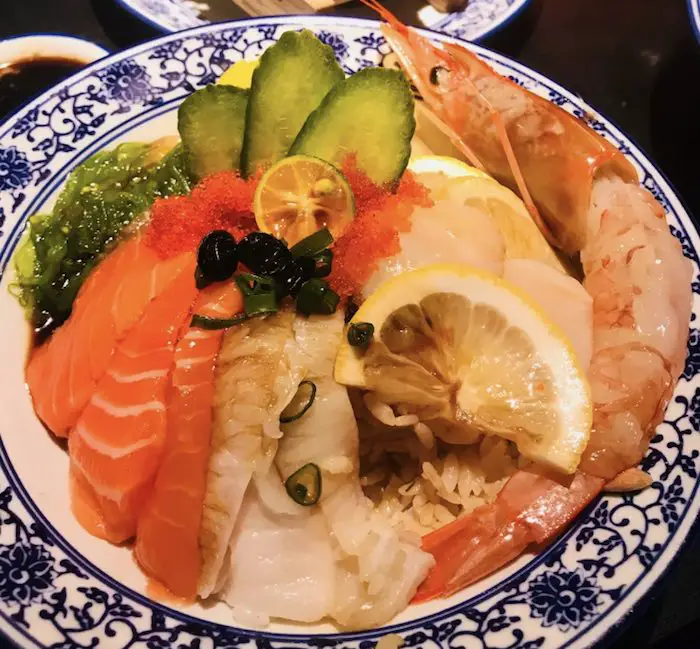
When someone with less cooking and knife skills asks me what’s the best type of sushi they can make at home, I always recommend Chirashi sushi (scattered sushi). This is one of the simplest, easiest to cook, and most varied type of sushi. You may use different types of ingredients in the recipe and enjoy your unique creation.
A friend once asked me ‘ how to eat chirashi sushi’ so I decided to dedicate this post to this topic. To eat chirashizushi, you may use chopsticks to take a few bites of toppings comprising of raw fish, seafood, or vegetables and then take a few bites of vinegared rice.
The sashimi rice bowl is often served with wasabi and soy sauce in the side. You can put a little wasabi on the raw fish, pick it with chopsticks and dip one end in the soy sauce. Now savor the taste of raw fish and then follow with a bite of delicious rice.
Contents
What Not To Do When Eating Chirashi Sushi
When eating at home, if you wish to dip the toppings with extra soy sauce, take a bowl of the sauce separately. Don’t pour into rice or else it will become soggy and difficult to eat with chopsticks. Those who are not comfortable using chopsticks can use their hands to eat the toppings and a spoon for rice.
Pouring rice over your sashimi rice bowl is also considered disrespectful in a high-end sushi restaurant. It comes under the don’ts of sushi eating etiquettes. A lot of effort goes into preparing the perfect sushi rice and pouring the excess sauce over it spoils the creation.
You must also ensure that you eat the toppings one by one, instead of stuffing them into your mouth. Savor each piece individually as this is the only way to understand the unique flavors and textures of different types of fish.
Reasons Behind The Popularity Of Chirashi Sushi
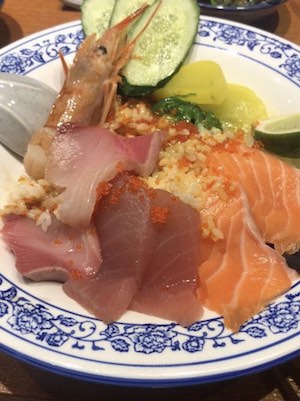
Yes, Chirashi is one of my favorites and I know those who are a beginner at sushi making and cannot roll and cut like a pro, love this style. So, when I am in the mood for vinegared rice, veggies and raw fish, but don’t want to make rolls, this is my go-to option.
Plus, there are so many variations you can enjoy with your sashimi rice bowl. It requires less preparation and can serve a lot of people at once. I also prefer making Chirashi when I have leftover sushi rice from the previous night of yummy sushi rolls dinner.
Just microwaving the rice for 30 seconds and mixing up all the remaining ingredients does the job. You have a satisfying meal ready within minutes and you don’t have to throw away all that leftovers. However, that does not mean that Chirashi Sushi is just a leftover option. I know many people who prefer this style over sushi rolls and nigiri.
So, if you are in the mood for a delicious sashimi rice bowl, here’s a quick recipe for you to try at home. Please remember that you will need to buy only the finest sushi-grade fish from the local Asian market or you may purchase it online from a reputed store such as the Catalina Offshore Products.
Steps To Make Chirashi Sushi (Sashimi Rice Bowl) At Home
You will need:
2 cups of seasoned sushi rice
2 tablespoon sesame seeds (optional)
2 fresh shiso leaves
3 tablespoon of tobiko (flying fish roe)
Finely sliced scallion
Sliced shiitake mushrooms
Other toppings of your choice – veggies, raw fish (tuna or salmon), raw seafood, fish roe (masago), tsukemono (Japanese pickled vegetables,) and tamago.
To make this style of sushi, you will need to buy Japanese short-grain rice, cook it well and cool it properly before using it in the recipe. Here are step-by-step instructions on how to cook sushi rice in cooker or pot.
Two Ways Of Making Chirashi
Now, you have two options for preparing chirashi. First, you may add some seasoned sushi rice at the bottom of a shallow bowl and then arrange the toppings (mainly sashimi slices of raw fish and seafood) over it. This style was pioneered in the Edo period in the 1990s and it is still the primary way they serve chirashi sushi at restaurants.
The second method is to mix the ingredients (mostly veggies and cooked fish like unagi) with seasoned sushi rice in a large bowl and then separate into individual portions. The toppings may be more or less depending on your personal preference. The number of toppings mentioned above is to make one bowl of chirashi sushi.
Serve with soy sauce, pickled ginger, chopsticks and a spoon to eat.
Making A Riceless Chirashi Sushi
If you are conscious of calories or you simply don’t wish to add rice into your chirashi bowl, you may prepare a bowl of only sashimi slices. A typical bowl of riceless Chirashizushi would include tako (octopus), surimi (imitation crab sticks), ika (squid), saba (mackerel), kajiki (blue marlin) and sake (salmon).
If you would like to add some colors to your chirashi bowl, include julienned carrots, sautéed onions, cooked spinach, salmon roe, bamboo shoots, bean sprouts, seaweed (nori strips), and hard-boiled eggs.
A Little About Chirashi Sushi’s History
This style of making scattered sushi became popular along with the maki sushi (traditional rolls) around the 18th century. The basic translation of Japanese Chirashi is sushi rice salad in English, and it gives an idea of what the dish is all about.
It is prepared in the form of a sushi salad with several ingredients scattered on the top of the vinegared rice. It is not rolled in Nori sheet, nor is it formed into a bed of rice. This no mess style of sushi is not only quick to prepare but perfect for family dinner.
If you have been to Japan, you will realize that the most popular style of traditional Chirashi bowl contains no meat. You will only find fried tofu, eggs, vegetables, and so on. Sometimes the sashimi rice bowl contains unique ingredients that you may not find in other sushi dishes. These include bamboo shoots, soboro, kamaboko, baby corn, and lotus root.
Difference between Chirashi, sashimi, and poke
Chirashi, as I have mentioned above, is a bowl containing ingredients we use in sushi (vinegared rice, veggies, raw fish, seafood, fruits). However, they are all arranged in a bowl and presentation is the main factor that differentiates chirashi from sashimi and poke.
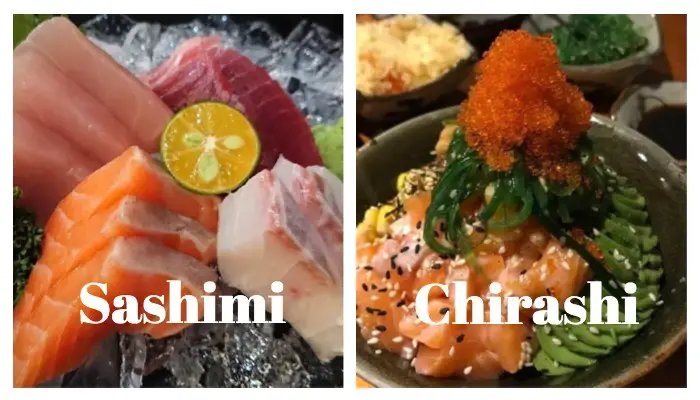
Sashimi comes from two words ‘sashi’ which means pierced or stuck and mi which means meat. The name is inspired by the practice of sticking the tail or fins to the sashimi slices to recognize the species of fish. This is a traditional Japanese food preparation where raw fish and seafood are sliced into fine pieces. They are dipped into soya sauce to further enhance the taste.
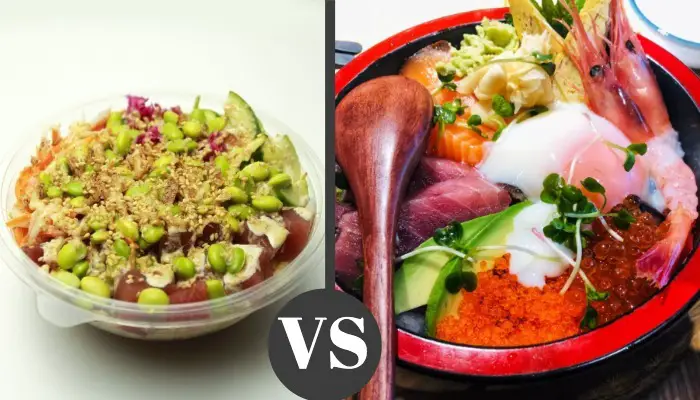
While sashimi has Japanese origins, Poke comes from Hawaii. Poke usually has one variety of raw fish or seafood unlike chirashi that has diverse ingredients. The raw pieces in Poke are cut in the shape of cubes and it does not contain any sushi rice.
Chirashi usually has no extra flavors than the vinegared sushi rice, so you get to enjoy raw fish texture and taste. Poke is created in the style of salad with chopped green onions, grated ginger, sesame oil, and chili peppers.
For more information: Chirashi VS Poke Chirashi vs Sashim
Related Questions
What are other names for chirashi sushi?
Depending on the local region, Chirashi sushi is often known as Gomoku Chirashi, Gomoku Sushi, or Bara Sushi. In Tokyo, people usually call it Gomoku Chirashi or Gomoku Sushi.
Should I eat the fish and rice part separately?
The real fun is to enjoy fish along with the seasoned sushi rice. I would recommend that you pick a piece of fish first, dip it in soy sauce or smear some wasabi on it and eat. Then grab some delicious sushi rice to complement the flavor of raw fish or seafood.
What should I do with the green sauce
The green sauce you are often served with chirashi bowl is grated wasabi that adds ‘heat’ to the dish. You may take the pieces of raw fish and dip them in wasabi before eating or add a few drops on the toppings before you pick the toppings using your chopsticks.
Should I eat sisho leaves whole or nibble it?
The Chirashi bowl often contains whole sisho leaves and beginners are often confused about how to eat it. I would recommend that you eat it whole instead of nibbling, although it’s completely up to you. The beauty of scattered sushi is that there’s no hard and fast rule. As long as you are not pouring soy sauce into your bowl, you may choose to eat fish first or mix fish with rice, or as you prefer.
Can I make vegetarian chirashi sushi?
Yes, you can make an all-vegetarian chirashi sushi bowl with delicious ingredients like julienned carrot, shiitake mushrooms, plum tomato, finely chopped baby spinach, sliced scallions, and shredded Nori strips.
Can I use substitutes for sushi rice?
If you are looking for healthier options, you may substitute white short grain rice with brown rice or quinoa.
Do they serve chirashi in sushi restaurants?
Yes, of course. If you are not sure about which roll to order or want a more filling meal, you may order a chirashi sushi bowl. It is usually my go-to meal when I am trying out a new sushi restaurant as it gives me an idea of how their sushi rolls and sashimi will taste like.
How many calories in a chirashi bowl?
In a traditional bowl of Japanese chirashi sushi, you have 505 calories that can be broken down into 80% carbs, 14% protein, and 6% fat.

